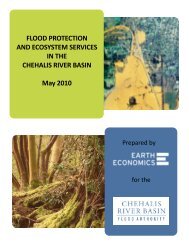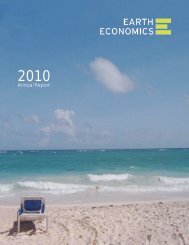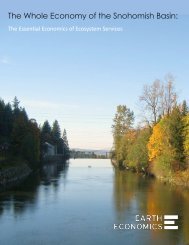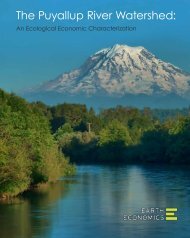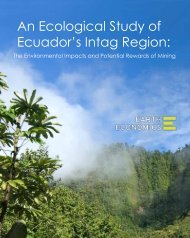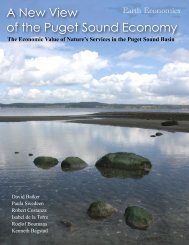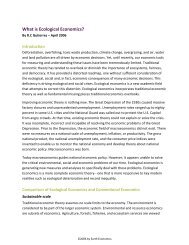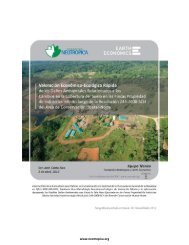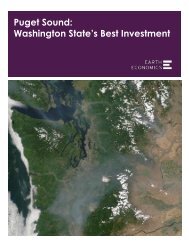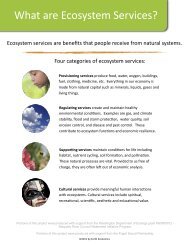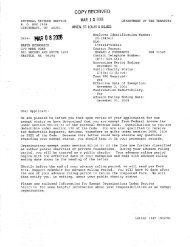The Spot Prawn Fishery: A Status Report - Earth Economics
The Spot Prawn Fishery: A Status Report - Earth Economics
The Spot Prawn Fishery: A Status Report - Earth Economics
You also want an ePaper? Increase the reach of your titles
YUMPU automatically turns print PDFs into web optimized ePapers that Google loves.
<strong>The</strong> <strong>Spot</strong> <strong>Prawn</strong> <strong>Fishery</strong>: A <strong>Status</strong> <strong>Report</strong><br />
and Management, aimed at improving the state<br />
of this type of biological and ecological knowledge.<br />
(See “<strong>Spot</strong> <strong>Prawn</strong> Stock Structure and<br />
Management” box below for details.)<br />
A pre-season test fishery has been carried out<br />
in Hood Canal since the 1970s. This research<br />
has been aimed at analyzing relative abundance<br />
and life history characteristics, such as length<br />
frequency ovigery (egg bearing), in order to set<br />
the harvest level for the coming season and determine<br />
the timing and duration of season openings.<br />
<strong>The</strong> Tulalip, Swinomish, and Suquamish<br />
Tribes also run pre-season test fisheries for<br />
ovigery to determine the percentage of female<br />
prawns that are egg-bearing. <strong>The</strong>se test fisheries<br />
are carried out in the central Sound/Whidbey<br />
Basin. <strong>The</strong> Hood Canal fishery presently is a<br />
recreational and tribal commercial fishery only.<br />
<strong>The</strong> State commercial fishery has been closed<br />
since 1992.<br />
<strong>The</strong> Puget Sound (excluding Hood Canal)<br />
Pandalid Shrimp Harvest Management Plan<br />
(2001a) recognizes that biological information<br />
about Puget Sound pandalid shrimp resources is<br />
currently limited. Both parties “share the goal of<br />
collecting and analyzing additional information to<br />
improve shrimp [prawn] management” (WDFW<br />
2001a). Additional biological information may be<br />
required in order to “make future assessments of<br />
allowable harvests and harvest methods.” This<br />
information may include the following:<br />
•develop quantitative survey methods to estimate<br />
the allowable catch by area, species, and<br />
gear type<br />
•biological basis for the establishment of harvest<br />
seasons; e.g., to deter harvest of ovigerous prawn<br />
•biological criteria for in-season data collection<br />
to evaluate harvest impacts and ensure proper<br />
resource utilization; e.g., count per pound<br />
•designation of minimum size limits of prawn<br />
and appropriate gear mesh size restrictions<br />
•designation of shrimp prawn nursery areas<br />
•identification of sub-areas needing unique<br />
management provisions<br />
•distribution and abundance of prawn species<br />
•methodology for estimation of non-commercial<br />
harvests and other fishery-related mortalities,<br />
including the bycatch of non-target species<br />
(WDFW 2001a)<br />
This additional biological information has not<br />
been collected to date. At the present time, the<br />
SPOT PRAWN STOCK STRUCTURE AND MANAGEMENT<br />
A three-year (2001, 2002, and 2003)<br />
Washington Sea Grant Program will<br />
support spot prawn research in<br />
Washington’s inshore and offshore<br />
fisheries.<strong>The</strong> need for this program<br />
arose from the fact that, despite the<br />
value of spot prawns to commercial<br />
and recreational fishing interests,<br />
little biological or ecological information<br />
is available for management.<br />
According to the Project<br />
Rationale,“<strong>The</strong> life cycle of these<br />
animals makes them especially vulnerable<br />
to overexploitation, so this<br />
information [the size, genetic structure,<br />
and relationship between the<br />
species’ various stocks] is necessary<br />
for sound management of the<br />
resource” (Lowry 2000).<br />
<strong>The</strong> Project’s primary objectives are:<br />
•“To use microsatellite DNA analysis<br />
to investigate the genetic relationships<br />
between prawns from the<br />
major fishing areas in Washington<br />
State, both inshore and offshore.<br />
•“To examine modeled and observed<br />
current and water property patterns<br />
to determine the likelihood of<br />
local retention and exchange of larvae<br />
between putative sub-populations.<br />
•“To use the above two types of<br />
information to define the ranges of<br />
the populations being fished.<br />
•“To use logbook data from the<br />
commercial fishery to determine<br />
major fishing areas offshore and<br />
develop an area-specific biomass<br />
dynamics model for use in setting<br />
maximum catches.<br />
•“To provide fishery management<br />
recommendations regarding<br />
resource sustainability, including<br />
habitat protection and the potential<br />
use of reserves as a management<br />
tool” (Lowry 2000).<br />
<strong>The</strong> Project methodology will<br />
involve sampling sites in both the<br />
offshore and inshore fisheries and<br />
comparing the genetic makeup of<br />
the animals in these two regions.<br />
Commercial fishing logbook data<br />
will be used to ensure that areas<br />
where spot prawns tend to aggregate<br />
are sampled. Genetic stock<br />
structure and distribution data will<br />
then be compared to oceanographic<br />
movement models in order to<br />
locate areas where larvae are transported,<br />
as well as where they are<br />
retained. An area-specific model of<br />
spot prawn population dynamics<br />
will be developed.<br />
This Project will allow the description<br />
of “the genetic stock structure<br />
of Washington stocks of spot<br />
prawns, within Puget Sound and<br />
the Northern Straits of San Juan de<br />
Fuca as well as offshore. Comparison<br />
of this with oceanographic features<br />
in the areas occupied by spot<br />
prawns will allow us to draw conclusions<br />
about the life history of the<br />
offshore spot prawn populations,<br />
interactions between sub-populations,<br />
and the importance of eddies<br />
to the retention of larvae in submarine<br />
canyons” (Lowry 2000).<br />
25



